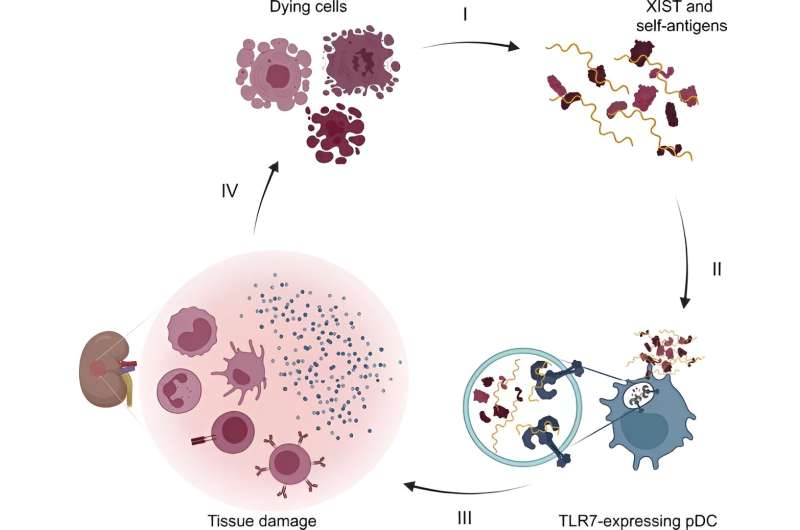This article has been reviewed according to Science X's editorial process and policies. Editors have highlighted the following attributes while ensuring the content's credibility:
fact-checked
peer-reviewed publication
trusted source
proofread
Researchers explore origins of lupus, find reason for condition's prevalence among women

For years, researchers and clinicians have known that lupus, an autoimmune condition, occurs in women at a rate nine times higher than in men. Some of the factors that cause the disease's high prevalence in women have eluded discovery, but in a new study investigating the immune system processes in lupus and the X chromosome, Johns Hopkins Medicine researchers have uncovered answers about the disease's frequency in females.
A number of dysregulated genetic and biological pathways contribute to the development of lupus and its varied symptoms of muscle and joint pain, skin rashes, kidney problems, and other complications throughout the body. One such pathway involves a protein in the immune system called toll-like receptor 7 (TLR7), which, in lupus, reacts to the body's own RNA, molecules that act as messengers of genetic information. TLR7's reaction to RNA triggers an immune response that damages healthy tissue.
In the full article, published in JCI Insight, researchers honed in on this TLR7 immune response in lupus, looking specifically at how a piece of genetic material only found in women, known as X-inactive specific transcript (XIST), could trigger TLR7's immune system response. XIST is a type of RNA that plays a crucial role in inactivating one of the two X chromosomes found in female cells so that females do not have imbalanced gene expression.
"XIST has previously been implicated in autoimmunity, but more as something that could prevent autoimmune conditions like lupus, rather than drive the disease's development," says study author Erika Darrah, Ph.D., adjunct professor of medicine at the Johns Hopkins University School of Medicine. She has since left the university but led the project. "Our findings show the opposite, that XIST actually plays a role in promoting autoimmunity—increasing the susceptibility to lupus and its severity in women."
Using cellular experiments, the research team first tested whether XIST could bind to TLR7 and initiate the receptor's immune response. They observed that XIST could strongly bind to TLR7 and trigger the production of molecules called interferons, an immune system protein seen at high levels in lupus that contributes to tissue damage in this disease.
Rather than protect from TLR7 and interferon's negative effects on the body, these tests illustrated that XIST drove the process of an overactive immune response and contributed to lupus development.
"XIST has now taken on a different role, an alarm signal related to autoimmunity," says study author Brendan Antiochos, M.D., assistant professor of medicine at the Johns Hopkins University School of Medicine. "The immune system activation through XIST and TLR7 is female-specific, helping explain the observation that lupus is so much more common in women compared to men."
To further study XIST's role in lupus, researchers also examined XIST levels in patients from two lupus cohorts. The team tested blood samples from patients at the Johns Hopkins Lupus Center for XIST levels, and also used publicly available data from another study that showed XIST and interferon levels in white blood cells taken from the kidneys of people with lupus.
They assessed that not only did the levels of XIST in the kidney correlate with higher interferon levels, but also, those with more XIST in their blood cells experienced greater disease severity and worsened lupus symptoms.
Darrah and Antiochos say these findings may implicate XIST in other autoimmune conditions that are more often seen in women, and that more research should be conducted to investigate this female-specific process.
Researchers also say that understanding XIST's role in lupus development may open the doors for creative therapies to treat the condition that target the XIST-TLR7 pathway, as well as offer an additional explanation for patients who may wonder about the origins of their disease.
More information: Jonathan D. Crawford et al, The XIST lncRNA is a sex-specific reservoir of TLR7 ligands in SLE, JCI Insight (2023). DOI: 10.1172/jci.insight.169344



















